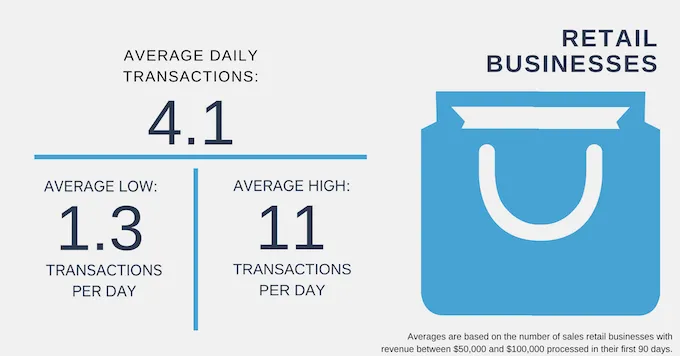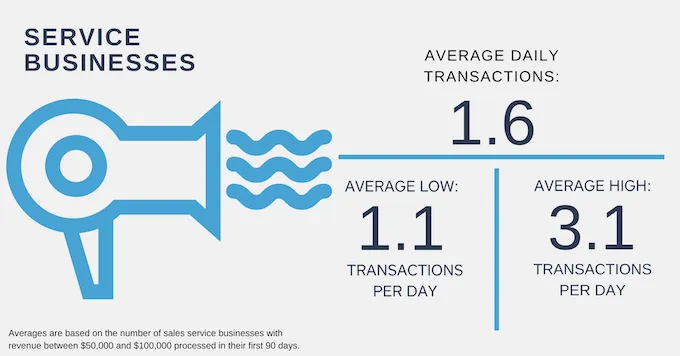Table of contents
You’ve been working for months to get ready and now it’s here — your business is finally open. The first few days are slow, with a couple of people trickling through the door. Then you hit a weekend and you’re pretty busy most afternoons. But come Monday, things are slow again.
You have this nagging feeling that the sales you’re doing aren’t enough.
Before you get too concerned, take a step back. First, you’re not alone. Almost every new business owner feels this way. Second, remind yourself that volatility in daily transactions is common at the beginning of a business’s life.
To show you what we mean, we looked at food and beverage, retail, and service businesses with revenue between $50,000 and $100,000 that use Square and analyzed the number of sales they processed in their first 90 days.
Here’s a look at what we found:
Price point plays a big role in how many sales you should expect each day. The relatively low price point of food and beverage items means that, on the whole, businesses that sell them average more transactions in a day than other types of businesses.
The average number of transactions for a food and beverage business is 11, while for a retail business it’s just over four, and for a service business it’s over one.
Price point also affects how much variance there is between a business’ slowest sales days and its busiest.
Food businesses see the most difference: On its best day, this type of business does almost three times more transactions than on an average day and nearly 15 times the transactions that it does on its slowest day.
So if you run a deli and only sell two sandwiches on Monday, don’t worry, you’re well within the norm.
For retailers, the difference between the busiest and slowest day is nearly 10 transactions. And on the best day, a retailer processes 2.6 times more transactions than on its average day.
Service businesses see the least variance, with a high of 3.1 and a low of 1.1 transactions.
The important takeaway here is that your sales can really vary from day to day, especially in the beginning. You’ll have some great days, some good days, and some not-so-good days. And while a single day of business should not be used as a barometer for your business’s health, you can use these averages as benchmarks.
That begs the question, if you shouldn’t judge your success by daily sales, what should you look at?
Before you look at anything, you need the right tools in place to help you really evaluate your business. Square’s point-of-sale system has built-in analytics that make data and insights easy to access and understand. That information can help you determine whether or not you’re growing and what’s spurring that growth, so you can make more informed decisions.
Once you have that set up, you should be doing these four things on a regular basis:
Review sales periodically
Instead of judging your health by a daily summary, look over longer periods of time. Are you seeing weekly growth? How about monthly growth?
Once you’ve established whether you’re seeing growing, declining, or stagnant sales, you can zero in on the causes to help you make informed decisions about where to make investments or create efficiencies.
Analyze your peaks and valleys
Once you’ve seen what your general sales trends look like, get a closer view. Look at your retail metrics for the busiest and slowest days and ask questions like these to try to determine what caused them:
- Do all your busiest days fall on the same day of the week?
- Are there certain times on those days when you are busier?
- Is there an external trigger, like construction on your street, that caused a slow day?
- Did you have active marketing campaigns that drove extra transactions during your busiest week, or does it have to do with the seasonality of your products or services?
Zoom in on your products and services
Identify your items that sell steadily and frequently and make sure they are always in stock.
Then look at what isn’t selling quite as well or quite so often. Are those items that you need to have in your inventory? If they’re higher-priced items, maybe you don’t need to sell quite so many to make it profitable to carry them. But if a product is just taking up shelf space, consider cutting down your inventory or not stocking it at all.
(If you don’t have a system to manage your inventory, consider investing in a POS that has built-in inventory management.)
Pinpoint your already-loyal customers
Do you already have customers who are coming back on a regular basis? These customers can be your champions and help you market your business.
So even if it’s only been a month and you have customers who came in more than twice, start building a relationship with them. After you talk with them, take notes about who they are and their likes and dislikes so you can try to remember them the next time they come in.
If you use a POS with a built-in CRM, you can put these notes into your customer directory. Then you can use their purchase history to make good recommendations on their next visit. (You can also use your CRM to engage these customers with news and promotions via email.)
Starting a business is stressful. There’s no need to add more stress by worrying whether or not you’re selling enough each day. With the right tools, you can not only get a handle on if your business is growing but also why it is (or isn’t), and what you can do to make sure it continues to do so.
![]()














